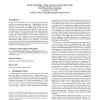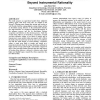1431 search results - page 10 / 287 » The complexity of random ordered structures |
SIGIR
2006
ACM
14 years 1 months ago
2006
ACM
We present a novel framework for answering complex questions that relies on question decomposition. Complex questions are decomposed by a procedure that operates on a Markov chain...
GECCO
2008
Springer
13 years 8 months ago
2008
Springer
This study proposes an agent-based model where adaptively learning agents with local vision who are situated in the Prisoner’s Dilemma game change their strategy and location as...
BMCBI
2008
13 years 7 months ago
2008
Background: Identification of approximate tandem repeats is an important task of broad significance and still remains a challenging problem of computational genomics. Often there ...
BMCBI
2006
13 years 7 months ago
2006
Background: One-dimensional protein structures such as secondary structures or contact numbers are useful for three-dimensional structure prediction and helpful for intuitive unde...
ICML
2010
IEEE
13 years 8 months ago
2010
IEEE
Markov logic networks (MLNs) use firstorder formulas to define features of Markov networks. Current MLN structure learners can only learn short clauses (4-5 literals) due to extre...


